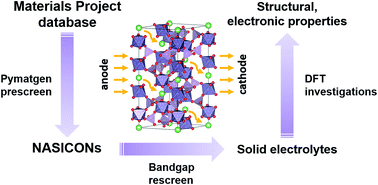Computational screening and first-principles investigations of NASICON-type LixM2(PO4)3 as solid electrolytes for Li batteries
Abstract
Li-containing NASICONs (Na super ionic conductors) usually have high ionic conductivity and can serve as solid electrolytes for Li batteries. In this work, we screened the Materials Project database and found seven kinds of LixM2(PO4)3 (M = Bi, Ge, In, Mo, Sb, Sc, and Zr) which could be applied as solid electrolytes for Li batteries. The most thermodynamically stable phases of each series of LixM2(PO4)3 were investigated through density functional theory computations. The results indicate that all these materials are wide-band-gap semiconductors with the band gap ranging from 3.55 to 4.88 eV. Meanwhile, the width of their electrochemical window is not directly related to the band gap; instead, it is mainly determined by the chemical potential of Li ions in these materials. Ab initio molecular dynamics simulations indicate that NASICONs with more Li ions or monoclinic symmetry possess higher Li ion conductivity at room temperature, among which Li3Bi2(PO4)3 has the highest conductivity of ∼10−3 S cm−1. Comprehensively considering the stability, the width of the electrochemical window, the band gap and the ionic conductivity, we propose that Li3Sc2(PO4)3 could be a very promising solid electrolyte for Li batteries.

- This article is part of the themed collection: 2018 Journal of Materials Chemistry A HOT Papers


 Please wait while we load your content...
Please wait while we load your content...